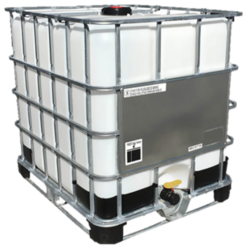Engineering:Caged IBC tote

Caged IBC totes are one of, if not the most commonly used, of all current intermediate bulk container design types. Caged IBC totes are handling and shipping containers for the storing, transit, and operation integration of various commodities, with the most common being water. Caged IBCs are often utilized as one-use containers, especially when it comes to hazardous materials, but are also suitable for reuse under many conditions.[1] This IBC type often features an interior liner, blow-mold manufactured from polyethylene, that is structurally supported by a protective cage frame, often of galvanized steel composition. Caged IBCs are engineered for the bulk handling of liquids, semi-solids, as well as solid materials. All materials can present certain safety and compatibility concerns, especially hazardous liquids,[2] and proper guidance is always recommended whenever using caged IBC totes for harsh chemicals.
Description
This IBC design type is a composite intermediate bulk container, as defined within Title 49 CFR,[3] and that has been tested and certified according to United Nations / DOT requirements for the transport and logistic handling of non-hazardous and hazardous materials, many times packing group II and III. Caged IBC containers can be fabricated according to various manufacturing requirements as well as construction materials for container durability and compatibility. The most commonly used caged IBC type and material are composite IBCs fabricated from high-density polyethylene within a galvanized steel frame, and used at capacities of 275 US gallons (1,040 L) and 330 US gallons (1,200 L).[4]
Engineering and specifications
Caged IBC totes are thermoplastic blow-mold engineered, often, from virgin high-density polyethylene (HDPE), a BPA free, strong plastic. Caged tote engineering is a top port inlet with cap for filling of cargo (commonly 6") with a bottom discharge outlet port--common is 2" ball valves--and an integrated pallet base skid for maneuvering the IBC. The pallet base of composite IBCs often features four-way access channels for universal handling by moving equipment such as forklifts and pallet jacks.
Caged IBC engineering has been to produce a multi-industry use container that is mobile, convenient, consistent, durable, as well as compatible. The high-density polyethylene used in the construction of rigid, poly caged IBC totes is a durable thermoplastic chosen for its compatibility with many chemicals and materials often employed throughout industries, commercial applications, agriculture as well as consumer-based uses, as caged IBCs are often repurposed for aquaponic gardening.
Caged intermediate bulk containers are standardized for manufacture to near a commonly-accepted pallet size. Caged IBCs are often 45"L x 40"W x 46"H for 275 gallons and 48"L x 40"W x 53"H for 330 gallons, where both volume types are available in either new, rebottled, or reconditioned model types, where: rebottled means a brand new HDPE liner in a previously-used but certified steel cage, and; reconditioned means a previously-used but cleaned and certified HDPE liner and cage[5]
Uses
Poly Caged IBC totes, of 275 and 330 US gallons (1,040 and 1,250 L), are frequently used for the following examples:
- Water | Potable, drinking, non-drinking, process, waste, by-product
- Chemicals | Acids, bases, oils, solvents, intermediates, ionic salt compounds (avoiding marked incompatibilities)
- Agriculture | Crop chemicals such as fertilizers, pesticides, herbicides, pesticides; Water
- Commercial | Production materials; Food industry ingredients, cargo; Construction materials, water, sand, paints, coatings[6]
Safety
Caged IBC totes are subject to stringent safety standards to ensure the safe storage and transport of materials. They must adhere to UN31HA1/Y certifications, approvals, and ratings, indicating they have passed tests for packing groups II and III hazardous materials. The totes' structure, consisting of a high-density polyethylene (HDPE) tank within a galvanized steel frame, offers chemical resistance and a strong, rust-resistant barrier, with a composite pallet that is stronger and lighter than wood or steel. An integrated 2" butterfly valve allows for precise control of liquid dispensing, ensuring safe and efficient handling of the container's contents.[7]
Acquisition and disposal
Acquiring new caged IBC totes typically involves purchasing from certified suppliers who provide containers that comply with necessary regulations and standards. The totes have a capacity of 330 gallons and are equipped with a 2" drain, 6" screw cap, and four-way forklift entry for easy maneuvering. The dimensions of a standard tote are 39" W x 47" L x 53" H, and they can be stacked to save space. Disposal or recycling of IBC totes must be conducted in accordance with local environmental regulations, and they are often reconditioned for reuse to reduce waste.[7]
References
- ↑ "Guidelines for the Reuse of Intermediate Bulk Containers (IBCs)". https://ribca.org/wp-content/uploads/2018/05/RIBCA_Guidelines_for_Reuse_May2018-1.pdf.
- ↑ "Guidance for the storage of liquids in intermediate bulk containers". Solvents Industry Association. https://www.mkb.nl/sites/default/files/downloadables_vno/sia-cba_guidance_plastic_ibcs.pdf.
- ↑ "eCFR — Code of Federal Regulations" (in en). https://www.ecfr.gov/cgi-bin/retrieveECFR?gp=1&SID=dfffa7a793363399369c880dd9cd53e9&ty=HTML&h=L&mc=true&n=pt49.3.178&r=PART#se49.3.178_1707.
- ↑ "IBC Tote Specifications: Understanding Costs, Sizes and Dimensions" (in en-US). IBC Tanks | The IBC Tote Authority. https://www.ibctanks.com/specifications.
- ↑ "Caged IBC Totes: Galvanized Steel Poly Composite IBCs". https://www.ibctanks.com/caged.
- ↑ "IBC Tote Frequently Asked Questions" (in en-US). IBC Tanks | The IBC Tote Authority. https://www.ibctanks.com/faq.
- ↑ 7.0 7.1 "Caged UN Rated Poly IBC Tote". New Pig. https://www.newpig.com/caged-ibc-tote/p/WIP2670. Retrieved 2023-11-06.
